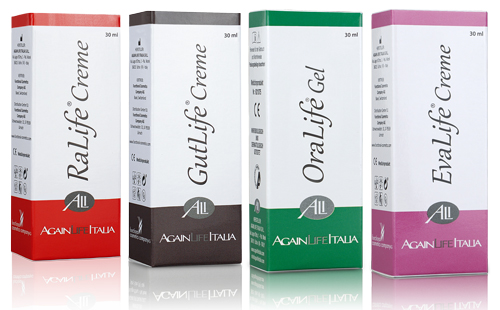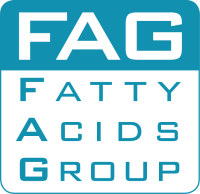Remedy for the Skin and Mucous Membrane in Cancer Therapy
The AgainLife® oncology care line based on F.A.G.® helps to maintain the functionality of the skin and mucous membranes during and after chemotherapy, hormone therapy and radiation therapy
 AgainLife After Care Products With the help of AgainLife® oncology care products you can minimize side effects and support your therapy positively. It is best to use AgainLife® products preventively, with the start of therapy.
AgainLife After Care Products With the help of AgainLife® oncology care products you can minimize side effects and support your therapy positively. It is best to use AgainLife® products preventively, with the start of therapy.
Radiation and chemotherapy save lives. The most common side effects of cancer therapy include nausea, fatigue, allergic reactions, hair loss, fever, and skin and mucous membrane infections. Cancer treatment not only slows down the cell growth of the harmful tumor cells. The reduced cell division affects the regulation of the moisture on the skin surface and the cell structure in the mucous membranes. This leads to dry skin and dry mucous membranes in the mouth, vaginal and anal areas. The consequences on the skin and mucous membrane are: dryness, redness, burning, swelling and pain.
The oncology care series from AgainLife® with OraLife®, EvaLife®, GutLife® and RaLife® helps in your local application against pain, inflammation and against dehydration - this, before, during and after chemotherapy or radiation therapy. All AgainLife® products are hormone-free and cortisone-free and tested for biocompatibility.
Care for the skin in cancer therapy
Over 18 million people develop cancer worldwide every year. Many of them can be helped - including chemotherapy, hormone therapy and radiation therapy. Chemotherapy can save lives. Yet the chemotherapy side effects are harsh ..How does chemotherapy work?
For cancer, chemotherapy is given either as the sole therapy or as a supplement to other therapies. By taking cytostatics, the tumour is supposed to be prevented from growing or even made to shrink. Cytostatics intervene in cell division. Since cancer cells divide particularly quickly, they are particularly susceptible to cytostatics. The way chemotherapy works is based on this.Where do the side effects of chemotherapy come from?
The drugs cannot differentiate whether the rapidly dividing cells they attack are good, normal cells in the body or tumour cells. Most of the chemotherapy side effects result from this problem. Rapidly dividing body cells are found, for example, in the bone marrow, in the hair roots, in various mucous membranes and in the germ cells. These cells are all attacked by the chemotherapy. The attack on the bone marrow weakens the immune system, the problems in the hair roots often cause the scalp hair to fall out and the problems in the germ cells sometimes result in the patient becoming sterile. The damage to the mucous membranes in the intestine can lead to diarrhoea, the damage to the mucous membranes in the mouth can lead to painful inflammation, and the mucous membrane in the vagina seems to dry out and is painful. The skin in the anal area is irritated by the diarrhoea and mucus secretions and often reacts with cracks and painful inflammations. Chemotherapy can also cause itchy and flaky skin. The skin may crack, discolour, or show allergy symptoms. The damaged skin and mucous membranes are also particularly susceptible to infections. Radiation therapy also damages the mucous membranes and skin. Although the beam acts specifically on the tumour, it runs in a straight line through the body and naturally also hits the skin and mucous membranes. Not everyone has the same side effects from chemotherapy, and different drugs cause slightly different side effects. The skin care in the treatment phase must be tailored to the respective skin problems.The inflamed skin from side effects of chemotherapy
Mast cells play an important role in inflammatory processes. How they work has not yet been fully researched, but they are capable of both triggering inflammatory reactions in the first place and fighting inflammation. If they overreact, they cause allergic reactions or severe inflammation. You can fight pathogens or cancer cells directly. For example, you can soften the effects of snake poison. And in early pregnancy they protect the embryo from being rejected. It is easy to imagine what happens when the side effects of chemotherapy disturb the balance of the mast cells. The skin feels dry, cracks, hurts, feels hot, swells or burns. The frequently given recommendation for skin care in the event of chemotherapy side effects is, in addition to cooling the affected areas of the skin, moisturizing skin care with an appropriate care product or an ointment. This should be free of hormones and cortisone so as not to provoke any interactions, and it should also be extremely well tolerated by sensitive, inflamed skin.AgainLife care product for skin and mucous membranes inflamed in cancer therapy
Protect the skin and mucous membrane with F.A.G.®
 If, during the inflammatory process, the mediators (consisting of fatty acids from the cell membrane) are not present in sufficient quantities to combat inflammation, this leads to damage to the skin and mucous membranes. F.A.G.® is able to provide exactly the fatty acids that the cells need to control the inflammatory process. Research on the biological modulation of inflammatory cells (B.M.I.C.®) led to the formation of a fatty acid compound (F.A.G.®) that can control the inflammatory process effectively and naturally - and this with excellent tolerance.
If, during the inflammatory process, the mediators (consisting of fatty acids from the cell membrane) are not present in sufficient quantities to combat inflammation, this leads to damage to the skin and mucous membranes. F.A.G.® is able to provide exactly the fatty acids that the cells need to control the inflammatory process. Research on the biological modulation of inflammatory cells (B.M.I.C.®) led to the formation of a fatty acid compound (F.A.G.®) that can control the inflammatory process effectively and naturally - and this with excellent tolerance.Modulation of mast cells and macrophages with F.A.G.®
F.A.G.® controls the hyperreactivity of the cells and ensures that inflammations do not overreact and lead to tissue damage. This happens by acting on the mediators, which are produced by the cells of the immune system, which are located on the corresponding receptors on the mast cells and macrophage cell membrane. These mediators are made up of fatty acids.This results in the 3-fold F.A.G.® effect
- controls inflammation relieves irritation and pain
- reduces oedema
 Deutsch
Deutsch
 English
English
 Français
Français




